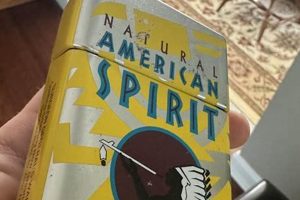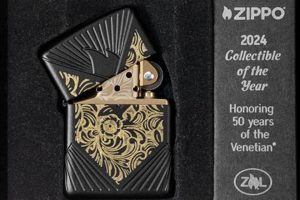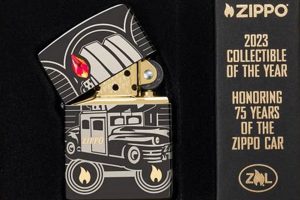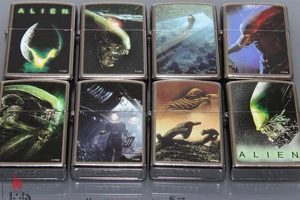The acquisition and curation of Zippo lighters, often focused on specific themes, dates, or designs, constitutes a popular hobby. For instance, enthusiasts might concentrate on lighters commemorating historical events, showcasing artistic engravings, or representing advertising campaigns. This practice often involves meticulous cataloging and careful storage to preserve the lighters’ condition.
This pursuit offers a tangible connection to history and design, providing collectors with opportunities to explore diverse artistic styles and manufacturing techniques. Building a collection can be intellectually stimulating, encouraging research into specific eras, brands, or artistic movements. Furthermore, the inherent durability and potential appreciation in value of certain Zippo lighters can make them attractive long-term investments. The hobby also fosters a sense of community, connecting individuals with shared interests through dedicated clubs, online forums, and trading events.
This article will delve into various aspects of this fascinating hobby, exploring the history of Zippo Manufacturing Company, examining notable lighter designs, and providing guidance on building and maintaining a collection. Further discussion will cover authentication techniques, proper storage methods, and resources for connecting with fellow enthusiasts.
Tips for Zippo Lighter Collecting
Building a meaningful collection requires careful consideration and planning. The following tips offer guidance for acquiring, preserving, and appreciating these iconic lighters.
Tip 1: Define Collecting Focus. Concentrating on a specific theme, such as military insignia, advertising, or a particular era, provides direction and prevents haphazard accumulation.
Tip 2: Research Thoroughly. Understanding the history, markings, and variations associated with chosen collecting areas helps identify authentic and valuable pieces.
Tip 3: Inspect Carefully. Before acquiring a lighter, examine it closely for signs of damage, repairs, or replaced parts, which can impact value and collectibility.
Tip 4: Authenticate Diligently. Utilize reputable resources, including official documentation and expert opinions, to verify a lighter’s authenticity and provenance.
Tip 5: Store Appropriately. Protect lighters from damage and deterioration by storing them in a controlled environment, away from extreme temperatures, humidity, and direct sunlight.
Tip 6: Document Meticulously. Maintain detailed records of each acquisition, including purchase date, price, seller information, and any relevant historical or design details.
Tip 7: Connect with Other Enthusiasts. Joining clubs, forums, and online communities provides opportunities to learn, share knowledge, and discover new additions for a collection.
By adhering to these guidelines, enthusiasts can cultivate collections that are both personally rewarding and historically significant. Careful planning, diligent research, and proper preservation ensure long-term enjoyment and potential appreciation of these miniature works of art and engineering.
This information provides a solid foundation for navigating the world of Zippo lighter collecting. The following sections will further explore specific collecting areas, offering detailed insights into particular themes and historical contexts.
1. Acquisition
Acquisition forms the foundational element of collecting Zippo lighters. Without a method for obtaining these items, building a collection remains impossible. This process encompasses various strategies and considerations that significantly impact the overall collecting experience.
- Sourcing Methods
Locating desirable lighters involves utilizing diverse channels. Online marketplaces, antique stores, flea markets, and specialized dealers represent common avenues. Each source presents unique advantages and challenges regarding price, authenticity, and selection. For example, online platforms offer vast inventories but require careful vetting of sellers. Antique shops may provide opportunities for discovering rare finds but often at premium prices.
- Budgeting and Valuation
Establishing a budget is crucial for responsible collecting. Prices vary dramatically depending on factors such as rarity, condition, and historical significance. Researching market values and understanding pricing trends helps collectors make informed purchasing decisions and avoid overspending. A limited-edition commemorative lighter, for instance, might command a significantly higher price than a standard production model.
- Negotiation and Purchasing
Acquiring lighters often involves negotiation, particularly when dealing with private sellers or at flea markets. Developing effective bargaining skills can lead to securing desirable pieces at favorable prices. Understanding market dynamics and having a clear idea of an item’s fair value strengthens one’s negotiating position.
- Ethical Considerations
Ethical acquisition practices are paramount. Collectors should prioritize purchasing from reputable sources and avoid items with questionable provenance. Respecting intellectual property rights and refraining from supporting counterfeit goods maintains the integrity of the collecting community. For example, purchasing lighters with unauthorized reproductions of copyrighted artwork poses ethical concerns.
These interconnected facets of acquisition directly influence the overall success and enjoyment of collecting Zippo lighters. Strategic sourcing, careful budgeting, skillful negotiation, and ethical considerations contribute to building a meaningful and valuable collection that reflects the collector’s interests and knowledge within the broader historical context of these iconic items.
2. Identification
Accurate identification is paramount within the realm of Zippo lighter collecting. Distinguishing authentic pieces from counterfeits, recognizing specific models and variations, and understanding the historical context of a lighter are crucial for building a reputable and valuable collection. Misidentification can lead to financial losses and diminish the historical significance of acquired items. The following facets outline key components of the identification process.
- Date Codes and Bottom Stamps
Zippo Manufacturing Company implemented a date code system stamped on the bottom of nearly every lighter since 1933. These markings allow collectors to pinpoint the manufacturing date and often the factory location. Decoding these stamps is essential for verifying a lighter’s age and authenticity. For example, a lighter with a date code of “F 06” indicates production in June 2006 in the Bradford, Pennsylvania factory. Accurate interpretation of these codes is crucial for establishing a lighter’s provenance.
- Model Variations and Features
Zippo produced a vast array of lighter models featuring unique designs, finishes, and mechanisms. Recognizing these variations allows collectors to categorize their lighters accurately and understand their relative rarity. Distinguishing a standard brushed chrome lighter from a limited-edition sterling silver model, for instance, significantly impacts its value and collectibility.
- Case and Insert Markings
Besides bottom stamps, other markings on the case and insert provide valuable identification clues. These might include patent numbers, trademarks, or special edition engravings. For instance, a lighter commemorating a specific historical event might feature unique engravings relevant to that occasion, adding to its historical significance and collectibility.
- Authenticity Verification
Counterfeit Zippo lighters exist in the marketplace. Collectors must employ various techniques to verify authenticity, including comparing markings against official documentation, examining construction details, and consulting expert opinions. Recognizing subtle differences in font styles, material quality, and manufacturing techniques can help differentiate genuine Zippos from counterfeits, safeguarding against fraudulent acquisitions.
Mastery of these identification facets is essential for discerning collectors. Accurate identification informs purchasing decisions, ensures the integrity of a collection, and enhances appreciation for the historical and manufacturing nuances embedded within each Zippo lighter. This careful scrutiny of details contributes significantly to the overall value and meaning associated with collecting these iconic pieces.
3. Preservation
Preservation represents a critical aspect of collecting Zippo lighters. Maintaining a lighter’s condition directly impacts its value, historical integrity, and aesthetic appeal. Neglecting proper preservation techniques can lead to irreversible damage, diminishing a collection’s overall significance. The relationship between preservation and collecting hinges on understanding the potential threats to these items and implementing appropriate preventative measures. For example, exposure to moisture can cause corrosion on the metal casing, while prolonged exposure to direct sunlight can fade painted finishes. Therefore, storing lighters in a controlled environment, away from extreme temperatures and humidity, is essential.
Several factors contribute to the deterioration of Zippo lighters. Environmental conditions, improper handling, and the inherent properties of the materials themselves play significant roles. Brass, a common material used in Zippo cases, is susceptible to tarnishing. Regular cleaning with appropriate materials, such as a soft cloth and specialized brass cleaner, helps prevent this. Furthermore, the flint wheel and internal mechanisms require periodic maintenance to ensure proper functionality. Lubricating moving parts and replacing worn flints preserves the lighter’s operational integrity, allowing collectors to appreciate not only its aesthetic qualities but also its intended function.
Preservation extends beyond individual lighters to encompass the entire collection. Utilizing appropriate storage solutions, such as dedicated display cases or protective sleeves, safeguards against damage from dust, scratches, and accidental impacts. Documentation also plays a crucial role in preservation. Maintaining detailed records of each lighter, including its provenance, condition, and any restoration efforts, enhances the collection’s historical value and provides essential information for future collectors. This meticulous approach to preservation ensures that these miniature pieces of history remain tangible and accessible for generations to come, preserving not only their physical form but also their historical and cultural significance.
4. Categorization
Categorization provides a crucial framework for organizing and understanding collections of Zippo lighters. A systematic approach to categorization enhances the collector’s ability to appreciate individual pieces within a broader context, facilitates research, and simplifies the management of potentially large and diverse holdings. Without a structured categorization system, collections can become unwieldy and lose their inherent value as curated historical artifacts. For example, a well-categorized collection might reveal trends in design or manufacturing techniques across different eras, offering insights beyond the individual lighters themselves.
- Chronological Categorization
Organizing lighters by their production date provides a historical overview of Zippo’s manufacturing evolution. This approach reveals design changes, material variations, and the impact of historical events on production. A collection categorized chronologically might showcase the evolution of bottom stamps or the introduction of new case finishes over time, providing a tangible timeline of Zippo’s history.
- Thematic Categorization
Grouping lighters based on shared themes, such as military insignia, advertising designs, or sports teams, allows collectors to explore specific areas of interest. This method fosters deeper understanding within a chosen niche and reveals connections between seemingly disparate lighters. A collection focused on advertising might showcase how brands utilized Zippo lighters as promotional tools, reflecting broader marketing trends of a particular era. For instance, a collection of lighters featuring automotive brands reveals the evolution of automotive logos and advertising aesthetics over time.
- Material and Finish Categorization
Classifying lighters based on case material and finish (e.g., brass, chrome, sterling silver) highlights the diversity of Zippo’s manufacturing processes. This approach emphasizes the aesthetic and material variations, allowing collectors to appreciate the craftsmanship and artistic techniques employed in creating these items. A collection categorized by materials might showcase the different finishes available throughout Zippo’s history, from high-polish chrome to unique textured finishes, offering insight into the company’s experimentation with materials and design.
- Rarity and Value Categorization
Organizing lighters based on their rarity and market value provides a framework for understanding the economic aspects of collecting. This approach assists in managing investments and recognizing potentially valuable pieces within a collection. A collection categorized by rarity might highlight limited-edition releases, rare prototypes, or lighters with unique historical provenance, providing insights into the factors that influence market value and collectibility. For example, a lighter commemorating a significant historical event or featuring a rare design error could be significantly more valuable than a standard production model. This understanding of rarity and value is crucial for informed collecting and potential investment considerations.
These diverse categorization approaches, when implemented strategically, transform a collection of Zippo lighters from a mere assortment of objects into a curated and meaningful representation of history, design, and cultural trends. By employing multiple categorization methods simultaneously, collectors gain deeper insights into their holdings, enabling them to appreciate each lighter’s unique attributes within a structured and informative context. This layered approach to categorization enhances the intellectual and aesthetic enjoyment of collecting, transforming it from a passive hobby into an active pursuit of knowledge and historical understanding.
5. Valuation
Valuation plays a crucial role in the realm of Zippo lighter collecting. Understanding the factors that influence a lighter’s worth is essential for making informed purchasing decisions, managing collections effectively, and appreciating the potential investment aspect of the hobby. Accurate valuation requires careful consideration of various interconnected elements, each contributing to a lighter’s overall market value and historical significance. Ignoring these factors can lead to misjudgments in purchasing or selling, potentially resulting in financial losses or missed opportunities. A seemingly common lighter might possess hidden value due to a rare manufacturing error or historical association, while a visually appealing lighter might be a less valuable reproduction.
- Rarity and Scarcity
The principle of supply and demand heavily influences Zippo lighter values. Limited-edition releases, discontinued models, and lighters commemorating specific events often command higher prices due to their scarcity. For instance, a lighter produced in limited quantities for a company’s anniversary celebration will likely be more valuable than a standard mass-produced model. Similarly, lighters associated with historical events, such as wartime commemoratives, often increase in value due to their historical significance and limited availability.
- Condition and Preservation
A lighter’s condition significantly impacts its value. Lighters in pristine, unused condition, often referred to as “mint” condition, generally command the highest prices. Signs of wear, scratches, dents, or missing parts detract from value. Proper preservation through appropriate storage and handling is crucial for maintaining a lighter’s condition and maximizing its potential value. A lighter with a scratched surface or a malfunctioning flint wheel will be worth less than an identical lighter in perfect working order. The presence of original packaging and accompanying documentation can also enhance a lighter’s value.
- Historical Significance and Provenance
Lighters associated with significant historical events or individuals can hold substantial value. Provenance, the documented history of ownership, further enhances this value. A lighter owned by a prominent historical figure, for instance, would likely command a premium price due to its unique historical association. Similarly, lighters carried by soldiers during wartime, especially if accompanied by documented provenance, often hold significant historical and monetary value. Establishing a clear chain of ownership adds to the lighter’s story and authenticity, contributing to its overall value.
- Market Trends and Demand
Zippo lighter values fluctuate based on market trends and collector demand. Certain designs, themes, or eras might experience periods of increased popularity, driving up prices. Staying informed about current market trends and collector preferences is essential for making informed purchasing and selling decisions. For example, a resurgence of interest in mid-century modern design might increase demand for Zippo lighters produced during that era, impacting their market value. Actively participating in collector communities and monitoring online marketplaces provides valuable insights into these dynamic trends.
These interconnected facets of valuation underscore the complexity of assessing a Zippo lighter’s worth. Rarity, condition, historical significance, and market dynamics all contribute to a lighter’s overall value. By understanding these elements, collectors can make informed decisions, build valuable collections, and appreciate the intricate relationship between history, craftsmanship, and market forces within the world of Zippo lighter collecting. Accurate valuation transforms collecting from a simple accumulation of objects into a nuanced appreciation of historical artifacts and their place within a dynamic marketplace.
6. Community
The social dimension of collecting Zippo lighters manifests significantly through vibrant communities. These networks of enthusiasts provide essential support, information exchange, and shared appreciation crucial for a fulfilling collecting experience. Connections forged within these communities often extend beyond the hobby itself, fostering lasting friendships and collaborative endeavors. The absence of such a community would isolate collectors, limiting access to valuable knowledge and diminishing the overall enjoyment derived from the hobby. For example, a novice collector struggling to identify a rare model might find immediate assistance through online forums or local collector clubs. Experienced members readily share expertise, guiding newcomers and fostering a sense of camaraderie. This collaborative spirit distinguishes Zippo lighter collecting from solitary pursuits, enriching the experience through shared passion and collective knowledge.
These communities operate through various channels, each offering unique advantages. Online forums and social media groups facilitate global connections, enabling collectors to share images, discuss finds, and exchange information regardless of geographical location. Local clubs and organized meetings provide opportunities for face-to-face interactions, fostering closer bonds and enabling direct examination of lighters. Specialized events, such as swap meets and auctions, bring collectors together to buy, sell, and trade, further strengthening community ties. These diverse platforms cater to different preferences and needs, ensuring accessibility for enthusiasts of all levels. A collector seeking a specific model might find it through a trade facilitated by a local club, while another might discover valuable information about a lighter’s history through discussions on an online forum. These interactions highlight the practical significance of community within the hobby, facilitating both the acquisition and understanding of collected items.
The community aspect of Zippo lighter collecting extends beyond mere camaraderie. Collective efforts within these communities contribute significantly to preserving the history and knowledge surrounding these iconic items. Members often collaborate on research projects, compile databases of rare models, and document historical information, ensuring that valuable knowledge is not lost. This shared commitment to preservation benefits not only current collectors but also future generations, safeguarding the legacy of Zippo lighters as historical artifacts. Challenges such as combating counterfeiting and preserving accurate information are also addressed collectively, demonstrating the community’s commitment to ethical practices and historical accuracy. This collective responsibility ensures the long-term integrity of the hobby, reinforcing the crucial link between community and the preservation of Zippo lighter history.
Frequently Asked Questions about Zippo Lighter Collecting
This section addresses common inquiries regarding the acquisition, identification, and preservation of Zippo lighters. The information provided aims to clarify potential misconceptions and offer practical guidance for enthusiasts of all levels.
Question 1: How can one differentiate between a genuine Zippo lighter and a counterfeit?
Authentic Zippo lighters exhibit specific markings, construction details, and material quality. Careful examination of the bottom stamp, case engravings, and insert markings helps verify authenticity. Consulting reputable resources and expert opinions provides additional validation. Counterfeits often exhibit inconsistencies in these details, revealing their inauthentic nature.
Question 2: What factors determine the value of a Zippo lighter?
Rarity, condition, historical significance, and market demand collectively influence a lighter’s value. Limited-edition releases, pristine condition, and association with historical events typically increase value. Market trends and collector preferences also play a significant role in determining current market prices.
Question 3: What is the significance of the date code stamped on the bottom of a Zippo lighter?
The date code pinpoints the lighter’s manufacturing date and often the factory location. This information is crucial for verifying authenticity, understanding production history, and establishing a lighter’s place within Zippo’s chronological timeline.
Question 4: What are the best practices for preserving a Zippo lighter collection?
Storing lighters in a controlled environment away from extreme temperatures, humidity, and direct sunlight is crucial. Regular cleaning with appropriate materials and periodic maintenance of the flint wheel and internal mechanisms ensures long-term functionality and preservation.
Question 5: Where can one acquire authentic Zippo lighters for a collection?
Reputable online marketplaces, antique stores, flea markets, and specialized dealers represent common acquisition channels. Exercising caution and verifying seller reputations are crucial for avoiding counterfeit items and ensuring authenticity.
Question 6: How can one connect with other Zippo lighter collectors?
Online forums, social media groups, and local collector clubs offer opportunities to connect with fellow enthusiasts. These platforms facilitate information exchange, trading opportunities, and shared appreciation for the hobby. Participating in these communities enhances the collecting experience and provides access to valuable knowledge.
Understanding these fundamental aspects of Zippo lighter collecting empowers enthusiasts to build meaningful collections, make informed decisions, and appreciate the historical and cultural significance of these iconic items. Careful research, diligent authentication, and proper preservation ensure long-term enjoyment and potential value appreciation.
This concludes the frequently asked questions section. Subsequent sections will delve further into specific collecting areas, offering detailed insights and guidance.
Conclusion
The exploration of Zippo lighter acquisition and curation reveals a multifaceted hobby rich in historical significance and collecting potential. From meticulous identification and preservation practices to the vibrant community fostering shared knowledge, the pursuit offers a tangible connection to historical events, design evolution, and material craftsmanship. Understanding market dynamics, authentication techniques, and proper storage methods empowers informed decision-making and responsible collection management.
The enduring appeal of these miniature metal canvases lies not only in their functional utility but also in their capacity to encapsulate historical narratives, artistic expression, and evolving cultural trends. Continued exploration and engagement within the collecting community promise further discovery and appreciation for the intricate world of Zippo lighters, ensuring their preservation as historical artifacts for generations to come. The careful study and documentation of these items contribute significantly to a broader understanding of material culture and its reflection of societal values across time.







